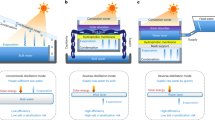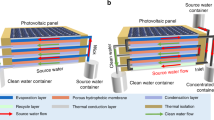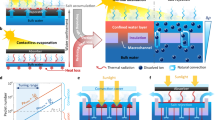Abstract
In recent years, interfacial solar steam generation has shown great potential for desalination with high solar-to-steam conversion efficiency. However, the freshwater production rate is still limited by the substantial latent heat of water evaporation and condensation efficiency. Here we designed an interfacial solar steam-driven reverse osmosis/nanofiltration device that generates high pressure that pushes water molecules through a filtration membrane to achieve separation from ions. The solar steam-driven reverse osmosis device reaches a water production rate as high as 81 kg m−2 h−1 under 12 sun illumination. Moreover, a theoretical model indicates that there still exists attractive room to further improve the freshwater output by optimizing the thermal insulation and expansion ratio of the device. This work paves a new way to design highly efficient miniaturized or decentralized drinking water devices.
This is a preview of subscription content, access via your institution
Access options
Subscribe to this journal
Receive 12 digital issues and online access to articles
$99.00 per year
only $8.25 per issue
Buy this article
- Purchase on Springer Link
- Instant access to full article PDF
Prices may be subject to local taxes which are calculated during checkout





Similar content being viewed by others
Data availability
The data generated or analysed during this study are included in this published article and its supporting information files. Source data are provided in this paper. Supplementary figure source data are also available on Figshare at https://doi.org/10.6084/m9.figshare.22188103.v1.
References
Mekonnen, M. M. & Hoekstra, A. Y. Four billion people facing severe water scarcity. Sci. Adv. 2, e1500323 (2016).
Haddeland, I. et al. Global water resources affected by human interventions and climate change. Proc. Natl Acad. Sci. USA 111, 3251–3256 (2014).
Shannon, M. A. et al. Science and technology for water purification in the coming decades. Nature 452, 301–310 (2008).
Zhou, L. et al. 3D self-assembly of aluminium nanoparticles for plasmon-enhanced solar desalination. Nat. Photonics 10, 393–398 (2016).
Wang, X. et al. An interfacial solar heating assisted liquid sorbent atmospheric water generator. Angew. Chem. Int. Ed. 131, 12182–12186 (2019).
Li, X. et al. Graphene oxide-based efficient and scalable solar desalination under one sun with a confined 2D water path. Proc. Natl Acad. Sci. USA 113, 13953–13958 (2016).
Zhou, L. et al. Self-assembly of highly efficient, broadband plasmonic absorbers for solar steam generation. Sci. Adv. 2, e1501227 (2016).
Hu, X. et al. Tailoring graphene oxide‐based aerogels for efficient solar steam generation under one sun. Adv. Mater. 29, 1604031 (2017).
Ni, G. et al. Steam generation under one sun enabled by a floating structure with thermal concentration. Nat. Energy 1, 16126 (2016).
Zhao, F. et al. Highly efficient solar vapour generation via hierarchically nanostructured gels. Nat. Nanotechnol. 13, 489–495 (2018).
He, S. et al. Nature-inspired salt resistant bimodal porous solar evaporator for efficient and stable water desalination. Energy Environ. Sci. 12, 1558–1567 (2019).
Xu, W. et al. Efficient water transport and solar steam generation via radially, hierarchically structured aerogels. ACS Nano 13, 7930–7938 (2019).
Zhang, P., Li, J., Lv, L., Zhao, Y. & Qu, L. Vertically aligned graphene sheets membrane for highly efficient solar thermal generation of clean water. ACS Nano 11, 5087–5093 (2017).
Li, Y. et al. 3D‐printed, all‐in‐one evaporator for high‐efficiency solar steam generation under 1 sun illumination. Adv. Mater. 29, 1700981 (2017).
Li, J. et al. Interfacial solar steam generation enables fast‐responsive, energy‐efficient, and low‐cost off‐grid sterilization. Adv. Mater. 30, 1805159 (2018).
Li, X., Cooper, T., Xie, W. & Hsu, P.-C. Design and utilization of infrared light for interfacial solar water purification. ACS Energy Lett. 6, 2645–2657 (2021).
Ghasemi, H. et al. Solar steam generation by heat localization. Nat. Commun. 5, 4449 (2014).
Bae, K. et al. Flexible thin-film black gold membranes with ultrabroadband plasmonic nanofocusing for efficient solar vapour generation. Nat. Commun. 6, 10103 (2015).
Xu, N. et al. Synergistic tandem solar electricity-water generators. Joule 4, 347–358 (2020).
Xia, Y. et al. Spatially isolating salt crystallisation from water evaporation for continuous solar steam generation and salt harvesting. Energy Environ. Sci. 12, 1840–1847 (2019).
Wu, L. et al. Highly efficient three-dimensional solar evaporator for high salinity desalination by localized crystallization. Nat. Commun. 11, 521 (2020).
Zhao, L. et al. A passive high-temperature high-pressure solar steam generator for medical sterilization. Joule 4, 2733–2745 (2020).
Yang, P. et al. Solar-driven simultaneous steam production and electricity generation from salinity. Energy Environ. Sci. 10, 1923–1927 (2017).
Zhang, Y. et al. Manipulating unidirectional fluid transportation to drive sustainable solar water extraction and brine-drenching induced energy generation. Energy Environ. Sci. 13, 4891–4902 (2020).
Li, J. et al. Over 10 kg m−2 h−1 evaporation rate enabled by a 3D interconnected porous carbon foam. Joule 4, 928–937 (2020).
Xu, N. et al. A scalable fish-school inspired self-assembled particle system for solar-powered water-solute separation. Natl Sci. Rev. 8, nwab065 (2021).
Xu, N. et al. Mushrooms as efficient solar steam‐generation devices. Adv. Mater. 29, 1606762 (2017).
Li, X. et al. Enhancement of interfacial solar vapor generation by environmental energy. Joule 2, 1331–1338 (2018).
Singh, S. C. et al. Solar-trackable super-wicking black metal panel for photothermal water sanitation. Nat. Sustain. 3, 938–946 (2020).
Shi, Y., Ilic, O., Atwater, H. A. & Greer, J. R. All-day fresh water harvesting by microstructured hydrogel membranes. Nat. Commun. 12, 2797 (2021).
Zhang, L. et al. Highly efficient and salt rejecting solar evaporation via a wick-free confined water layer. Nat. Commun. 13, 849 (2022).
Zhou, L., Li, X., Ni, G. W., Zhu, S. & Zhu, J. The revival of thermal utilization from the Sun: interfacial solar vapor generation. Natl Sci. Rev. 6, 562–578 (2019).
Li, X. et al. Storage and recycling of interfacial solar steam enthalpy. Joule 2, 2477–2484 (2018).
Menon, A. K., Haechler, I., Kaur, S., Lubner, S. & Prasher, R. S. Enhanced solar evaporation using a photo-thermal umbrella for wastewater management. Nat. Sustain. 3, 144–151 (2020).
Ni, G. et al. A salt-rejecting floating solar still for low-cost desalination. Energy Environ. Sci. 11, 1510–1519 (2018).
Tao, P. et al. Solar-driven interfacial evaporation. Nat. Energy 3, 1031–1041 (2018).
Xu, Z. et al. Ultrahigh-efficiency desalination via a thermally-localized multistage solar still. Energy Environ. Sci. 13, 830–839 (2020).
Zhang, L. et al. Passive, high-efficiency thermally-localized solar desalination. Energy Environ. Sci. 14, 1771–1793 (2021).
Brogioli, D., La Mantia, F. & Yip, N. Y. Thermodynamic analysis and energy efficiency of thermal desalination processes. Desalination 428, 29–39 (2018).
Chiavazzo, E., Morciano, M., Viglino, F., Fasano, M. & Asinari, P. Passive solar high-yield seawater desalination by modular and low-cost distillation. Nat. Sustain. 1, 763–772 (2018).
Hu, Y. et al. A reconfigurable and magnetically responsive assembly for dynamic solar steam generation. Nat. Commun. 13, 4335 (2022).
Mu, X. et al. A robust starch-polyacrylamide hydrogel with scavenging energy harvesting capacity for efficient solar thermoelectricity-freshwater cogeneration. Energy Environ. Sci. 15, 3388–3399 (2022).
Wang, F. et al. A high-performing single-stage invert-structured solar water purifier through enhanced absorption and condensation. Joule 5, 1602–1612 (2021).
Xu, N. et al. A water lily-inspired hierarchical design for stable and efficient solar evaporation of high-salinity brine. Sci. Adv. 5, eaaw7013 (2019).
Wang, W. et al. Simultaneous production of fresh water and electricity via multistage solar photovoltaic membrane distillation. Nat. Commun. 10, 3012 (2019).
Geng, H. et al. Plant leaves inspired sunlight-driven purifier for high-efficiency clean water production. Nat. Commun. 10, 1512 (2019).
Spiegler, K. & El-Sayed, Y. The energetics of desalination processes. Desalination 134, 109–128 (2001).
Stoughton, R. & Lietzke, M. Calculation of some thermodynamic properties of sea salt solutions at elevated temperatures from data on NaCl solutions. J. Chem. Eng. Data 10, 254–260 (1965).
Wang, Z. et al. Pathways and challenges for efficient solar-thermal desalination. Sci. Adv. 5, eaax0763 (2019).
Elimelech, M. & Phillip, W. A. The future of seawater desalination: energy, technology, and the environment. Science 333, 712–717 (2011).
Kwon, J.-S., Jang, C. H., Jung, H. & Song, T.-H. Effective thermal conductivity of various filling materials for vacuum insulation panels. Int. J. Heat Mass Transf. 52, 5525–5532 (2009).
Wakili, K. G., Stahl, T. & Brunner, S. Effective thermal conductivity of a staggered double layer of vacuum insulation panels. Energy Build. 43, 1241–1246 (2011).
Organ, A. J. Thermodynamics and Gas Dynamics of the Stirling Cycle Machine (Cambridge Univ. Press, 1992).
Formosa, F. & Despesse, G. Analytical model for Stirling cycle machine design. Energy Convers. Manag. 51, 1855–1863 (2010).
Bao, J. & Zhao, L. A review of working fluid and expander selections for organic Rankine cycle. Renew. Sust. Energ. Rev. 24, 325–342 (2013).
DeRosa, R. L., Schader, P. A. & Shelby, J. E. Hydrophilic nature of silicate glass surfaces as a function of exposure condition. J. Non-cryst. Solids 331, 32–40 (2003).
Xiong, Z. C., Zhu, Y. J., Qin, D. D., Chen, F. F. & Yang, R. L. Flexible fire‐resistant photothermal paper comprising ultralong hydroxyapatite nanowires and carbon nanotubes for solar energy‐driven water purification. Small 14, 1803387 (2018).
Zhang, Q., Xu, W. & Wang, X. Carbon nanocomposites with high photothermal conversion efficiency. Sci. China Mater. 61, 905–914 (2018).
Henke, S., Kadlec, P. & Bubník, Z. Physico-chemical properties of ethanol—compilation of existing data. J. Food Eng. 99, 497–504 (2010).
Edition, F. Guidelines for drinking-water quality. WHO Chronicle 38, 104–108 (2011).
Acknowledgements
We acknowledge the micro-fabrication centre of the National Laboratory of Solid State Microstructures (NLSSM) for technique support. J.Z. acknowledges support from the XPLORER PRIZE. This work was jointly supported by the National Natural Science Foundation of China (nos. 51925204, 52102262, 52003116 and 92262305), Natural Science Foundation of Jiangsu Province (nos. BK20220035 and BK20200340), National Key Research and Development Program of China (no. 2022YFA1404704), Program for Innovative Talents and Entrepreneur in Jiangsu Province and Jiangsu Planned Projects for Postdoctoral Research Funds (no. 2020Z018) and Nanjing University of Aeronautics and Astronautics Startup Fund (4017-YQR22012).
Author information
Authors and Affiliations
Contributions
J.Z., X.L. and X.W. conceived and planned this research. X.W., Y.S., W.Z. and S.W. did the experiments. X.W., Z.L., J.G., Z.X., N.X., J.L. and H.F. contributed to the thermal model and theoretical calculation analysis. X.W., Z.L., N.X., J.L., B.Z., X.L., R.W. and J.Z. organized the data and wrote the paper. All authors discussed the results and approved the final version of the paper.
Corresponding authors
Ethics declarations
Competing interests
The authors declare no competing financial interests. Readers are welcome to comment on the online version of the paper.
Peer review
Peer review information
Nature Water thanks Jianhua Zhou and the other, anonymous, reviewers for their contribution to the peer review of this work.
Additional information
Publisher’s note Springer Nature remains neutral with regard to jurisdictional claims in published maps and institutional affiliations.
Supplementary information
Supplementary Information
Supplementary Notes 1–5, Figs. 1–21, Tables 1–7 and refs. 1–47.
Source Data Supplementary Fig. 2
Statistical source data.
Source Data Supplementary Fig. 5
Statistical source data.
Source Data Supplementary Fig. 6
Statistical source data.
Source Data Supplementary Fig. 9
Statistical source data.
Source Data Supplementary Fig. 12
Statistical source data.
Source Data Supplementary Fig. 13
Statistical source data
Source Data Supplementary Fig. 15
Statistical source data.
Source Data Supplementary Fig. 16
Statistical source data.
Source Data Supplementary Fig. 19
Statistical source data.
Source Data Supplementary Fig. 20
Statistical source data.
Source data
Source Data Fig. 1
Statistical source data.
Source Data Fig. 3
Statistical source data.
Source Data Fig. 4
Statistical source data.
Source Data Fig. 5
Statistical source data.
Rights and permissions
Springer Nature or its licensor (e.g. a society or other partner) holds exclusive rights to this article under a publishing agreement with the author(s) or other rightsholder(s); author self-archiving of the accepted manuscript version of this article is solely governed by the terms of such publishing agreement and applicable law.
About this article
Cite this article
Wang, X., Lin, Z., Gao, J. et al. Solar steam-driven membrane filtration for high flux water purification. Nat Water 1, 391–398 (2023). https://doi.org/10.1038/s44221-023-00059-8
Received:
Accepted:
Published:
Issue Date:
DOI: https://doi.org/10.1038/s44221-023-00059-8
This article is cited by
-
Structure integration and architecture of solar-driven interfacial desalination from miniaturization designs to industrial applications
Nature Water (2024)
-
Structural integration of solar desalination system
Science China Materials (2024)



